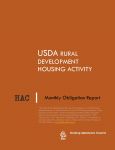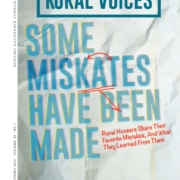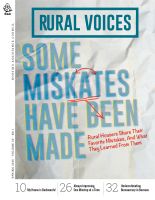HAC News: May 13, 2015
HAC News Formats. pdf
May 13, 2015
Vol. 44, No. 10
• House committee approves THUD spending bill • Senate passes budget agreement • HUD offers lead-paint grants • New version of USDA’s multifamily Preliminary Assessment Tool available • HUD and USDA determine new energy efficiency standards will apply • Guidance released to extend CDBG disaster grants from Hurricane Sandy • Dates set for Section 538 calls • FHFA announces extension of HARP • Worst Case Housing Needs 2015 Report to Congress released • Limits on GSE lending for multifamily mortgages eased • Federal rental assistance and Housing Choice voucher fact sheets released • Webinar recording on Native American housing available • HAC conference on “Serving Veterans in Rural America” set for May 20
HAC News Formats. pdf
May 13, 2015
Vol. 44, No. 10
HOUSE COMMITTEE APPROVES THUD SPENDING BILL. On May 13, the House Appropriations Committee passed the Transportation-HUD subcommittee’s FY16 appropriations bill without changes to HUD spending levels (see HAC News, 4/29/15). The committee rejected an amendment to provide $1.06 million for HOME without diverting money from the National Housing Trust Fund, offered by Rep. Barbara Lee (D-CA).
SENATE PASSES BUDGET AGREEMENT. On May 5, the Senate voted 51 to 48 to approve the House budget, which adds military spending while keeping cuts affecting social programs in place (see HAC News, 4/3/15). The budget is not binding and does not require presidential signature, but it does impose overall caps on federal spending.
HUD OFFERS LEAD-PAINT GRANTS. Local, county, state, and tribal governments can apply for the Lead Hazard Reduction Demonstration and Lead-Based Paint Hazard Control grant programs by June 23. Contact Eric Hornbuckle, HUD, 202-402-7599.
NEW VERSION OF USDA’S MULTIFAMILY PRELIMINARY ASSESSMENT TOOL AVAILABLE. Version 4.0 of the tool for Section 515 or 514 borrowers (see HAC News, 12/22/14) should be used when applying to transfer ownership or for the Multi-Family Housing Revitalization Demonstration Program (at the links, click the “Forms & Resources” tabs). Borrowers that used older PAT guidelines and submitted transactions after December 16, 2014 must use the new version. Contact an RD State Office.
HUD AND USDA DETERMINE NEW ENERGY EFFICIENCY STANDARDS WILL APPLY. New standards will be required for newly constructed homes with USDA Section 502 direct and guaranteed loans and for FHA-insured multifamily and single-family properties. For the HOME program, the standards will apply after publication of guidance by HUD. For more information contact Meghan Walsh, USDA, 202-205-9590.
GUIDANCE RELEASED TO EXTEND CDBG DISASTER GRANTS FROM HURRICANE SANDY. Expenditure extensions can be made for 24 months. For more information, contact Stanley Gimont, HUD, 202-708-3587.
DATES SET FOR SECTION 538 CALLS. To receive emails announcing dates for calls or web meetings in 2015 and 2016, contact Monica Cole at 202-720-1251. Topics will include program activities, perspectives on the current state of debt financing and its impact on the Section 538 program, enhancing the use of program financing with the transfer or preservation of Section 515 units, and the impact of LIHTC program changes on Section 538 program financing.
FHFA ANNOUNCES EXTENSION OF HARP. The Home Affordable Refinance Program will continue through the end of 2016. Launched in 2009 to provide relief to borrowers through lowering monthly payments, HARP was originally set to expire December 31, 2013.
WORST CASE HOUSING NEEDS 2015 REPORT TO CONGRESS RELEASED. HUD reports that although very low-income renters with worst case needs (those who do not receive government housing aid and paid more than half their income for rent, lived in severely inadequate conditions, or both) decreased slightly from 2011 to 2013, need remains high. Nonmetro areas experience less worst case need overall, but face other challenges including high utility costs.
LIMITS ON GSE LENDING FOR MULTIFAMILY MORTGAGES EASED. Fannie Mae and Freddie Mac can increase their financing of multifamily mortgages this year in order to avoid tighter multifamily credit and borrowing costs. Caps will remain at $30 billion each; however, multifamily loans that meet certain qualifications can be excluded. Qualifications are based on the percentage of units priced under a certain area median income, whether the property is in a high cost market, if the units target seniors, and if the property is mixed-income targeted affordable housing.
FEDERAL RENTAL ASSISTANCE AND HOUSING CHOICE VOUCHER FACT SHEETS RELEASED. The Center on Budget and Policy Priorities fact sheets provide state level data on the impacts of HUD rental assistance, the Housing Choice Voucher Program, Housing Choice Voucher utilization data, and sequestration cuts in Housing Choice Vouchers.
WEBINAR RECORDING ON NATIVE AMERICAN HOUSING AVAILABLE. On March 24, HUD hosted a panel discussion and webcast entitled “Native American Housing: Obstacles and Opportunities.” Speakers provided data and described best practices.
HAC CONFERENCE ON “SERVING VETERANS IN RURAL AMERICA” SET FOR MAY 20. Cosponsored by HAC and The Home Depot Foundation, this event in Washington, DC will provide information on housing, health, and employment needs and programs for rural veterans, with a special focus on successful local projects. There is no charge, but registration is requested. To register or for more information, email janice@ruralhome.org.




